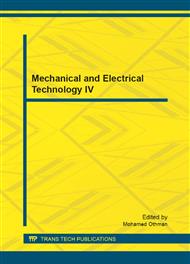[1]
E. Tremblay, S. Atayde and A. Chandra, Comparative Study of Control Strategies for the Doubly Fed Induction Generator in Wind Energy Conversion Systems: A DSP-Based Implementation Approach, IEEE Trans. Sustainable Energy, Vol. 2, No. 3, pp.1-11, July (2011).
DOI: 10.1109/tste.2011.2113381
Google Scholar
[2]
J. Hu and Y. He, Reinforced Control and Operation of DFIG-Based Wind-Power-Generation System Under Unbalanced Grid Voltage Conditions, IEEE Trans., Energy Conversion, Vol. 24, No. 4, pp.905-915, Dec. (2009).
DOI: 10.1109/tec.2008.2001434
Google Scholar
[3]
D. Gautam, , V. Vittal and T. Harbour, Impact of Increased Penetration of DFIG-Based Wind Turbine Generators on Transient and Small Signal Stability of Power Systems, IEEE Trans., Power Systems, Vol. 24, No. 3, pp.1426-1434, August (2009).
DOI: 10.1109/tpwrs.2009.2021234
Google Scholar
[4]
H. Babazadeh, W. Gao and X. Wang, Controller Design for a Hybrid Energy Storage System Enabling Longer Battery Life in Wind Turbine Generators, Bristol, North American Power Symposium (NAPS), 23 Sep. (2011).
DOI: 10.1109/naps.2011.6025178
Google Scholar
[5]
O. Anaya-Lara, FM. Hughes, N. Jenkins and G. Strbac, Rotor Flux Magnitude and Angle Control Strategy for Doubly Fed Induction Generators, Wiley Interscience, Wind Energy , Vol. 9, pp.479-495, June (2006).
DOI: 10.1002/we.198
Google Scholar
[6]
F. M. Hughes, O. Anaya-Lara, N. Jenkins and G. Strbac, A Power System Stabilizer for DFIG-Based Wind Generation, IEEE Trans. Power Syst., Vol. 21, No. 2, p.763–772, May (2006).
DOI: 10.1109/tpwrs.2006.873037
Google Scholar
[7]
R. Pena, J. C. Clare, and G. M. Asher, Doubly Fed Induction Generator Using Back-to-Back PWM Converters and Its Application to Variable-Speed Wind-Energy, IEE Proc. Electr. Power Appl., Vol. 143, p.231–241, May (1996).
DOI: 10.1049/ip-epa:19960288
Google Scholar
[8]
N. R. Watson and J. Arrillaga, Power Systems Electromagnetic Transients Simulation, the institution of engineering and technology, London, United Kingdom, (2003).
Google Scholar
[9]
K. Elkington, V. Knazkins and M. Ghandhari, On The Rotor Angle Stability of Power Systems With Doubly Fed Induction Generators, IEEE Power Tech. 2007, Lausanne, pp.213-218, 1-5 July (2007).
DOI: 10.1109/pct.2007.4538319
Google Scholar
[10]
O. Anaya-Lara, FM. Hughes, N. Jenkins and G. Strbac, Rotor Flux Magnitude and Angle Control Strategy for Doubly Fed Induction Generators, Wiley Interscience, Wind Energy, Vol. 9, pp.479-495, June (2006).
DOI: 10.1002/we.198
Google Scholar
[11]
R. G. Almeida, J. A. Lopes and J. A. L. Barreiros Improving Power System Dynamic Behavior Through Doubly Fed Induction Machines Controlled by Static Converter Using Fuzzy Control, IEEE Trans., Vol. 19, No. 4, pp.1942-1950, Nov. (2004).
DOI: 10.1109/tpwrs.2004.836271
Google Scholar


